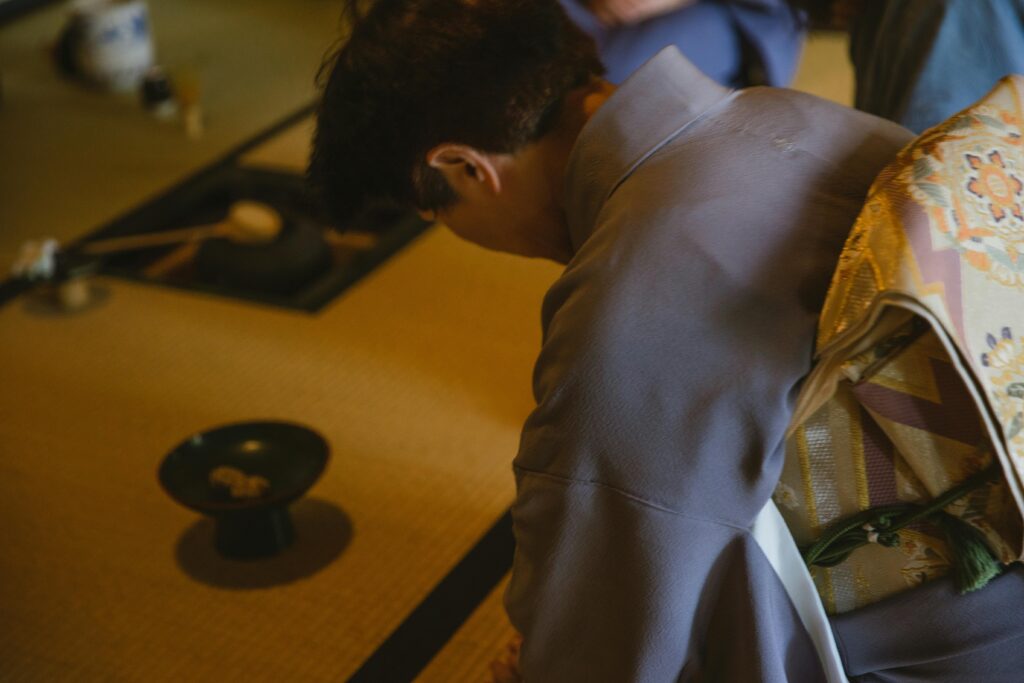Definition of tea-master in the matcha glossary

Origins and Historical Evolution of the Tea-Master
A tea-master (or chajin in Japanese) is an expert practitioner who has mastered the art of preparing and serving matcha through the Japanese tea ceremony. This role emerged during the Kamakura period (1185-1333) when tea culture first took root among samurai warriors and Zen Buddhist monks. The practice was introduced by Zen monk Yosai, who recognized tea’s spiritual and medicinal benefits.
Tea-masters evolved from simple tea preparers into cultural authorities who shaped aesthetics, philosophy, and social rituals. During the Warring States period (1467-1590), powerful warlords like Oda Nobunaga and Toyotomi Hideyoshi employed tea-masters as political advisors. The ceremony became a tool for diplomacy and power, elevating the tea-master’s status significantly.
The role reached its pinnacle with Sen no Rikyū (1522-1591), who codified the principles of wabi-cha—a style emphasizing simplicity, humility, and spiritual depth. His influence established the foundation for all modern tea ceremony schools.
Training and Certification Requirements
Traditional Learning Pathways
Becoming a tea-master requires years of dedicated study within established tea schools. The training encompasses far more than matcha preparation techniques. Students must develop proficiency across multiple disciplines to achieve mastery.
The core curriculum includes precise tea-making skills, Zen Buddhist philosophy, and ceremonial etiquette. Each gesture, movement, and ritual carries specific meaning and must be executed with mindfulness. Water temperature control, whisking technique, and serving protocols demand constant practice to perfect.
Essential Competencies
Tea-masters must cultivate expertise in several complementary arts:
- Calligraphy for understanding scroll messages displayed during ceremonies
- Flower arrangement (ikebana) to create seasonal displays in the tea room
- Incense appreciation (kōdō) for selecting appropriate fragrances
- Pottery knowledge to evaluate and select tea utensils appropriately
- Architectural understanding of tea room design and spatial harmony
Formal certification comes through structured progression within tea schools like Urasenke or Omotesenke. These lineages maintain strict standards to preserve authentic traditions across generations.
Legendary Tea-Masters Who Shaped Matcha Culture
Several historical figures transformed tea ceremony from ritual into art form. Their philosophies continue influencing how matcha is prepared and appreciated today.
Sen no Rikyū: The Greatest Tea-Master
Sen no Rikyū remains the most influential figure in tea history. He perfected the wabi-cha aesthetic, which rejected ostentation in favor of rustic simplicity and spiritual purity. His four principles—harmony, respect, purity, and tranquility—define the ceremony’s essence.
Rikyū’s descendants founded the three major tea schools that continue his legacy. These schools preserve his teachings while adapting to contemporary contexts.
Other Notable Masters
- Murata Shuko (1422-1502) – Considered the father of the Way of Tea, introduced spiritual values and simplicity
- Takeno Jōō (1502-1555) – Developed a natural, personal ceremony style that influenced Rikyū
- Furuta Oribe (1543-1615) – Created a dynamic “beauty in motion” approach as samurai tea-master
- Kobori Enshū (1579-1647) – Blended elegance with simplicity in the kireisabi style
Each master contributed unique perspectives that enriched the tradition. Their innovations demonstrate how tea culture continuously evolves while maintaining core principles.
The Tea-Master’s Role in Matcha Preparation
Tea-masters possess specialized knowledge that transforms matcha preparation into choreographed artistry. Every aspect of the process reflects their training and aesthetic sensibility.
The whisking technique represents one of the most critical skills. Tea-masters create either usucha (thin tea) with a light, frothy consistency or koicha (thick tea) with a smooth, paste-like texture. The bamboo whisk (chasen) moves in precise patterns—typically a rapid “W” or “M” motion—to achieve the perfect consistency without creating large bubbles.
Quality Selection and Seasonal Awareness
Tea-masters evaluate matcha quality through multiple criteria. They assess color vibrancy, aroma complexity, particle fineness, and flavor balance. Premium ceremonial-grade matcha exhibits a brilliant jade green color and sweet, umami-rich taste without bitterness.
Seasonal considerations influence every ceremony element:
- Summer ceremonies use lighter matcha servings in wider bowls to cool quickly
- Winter ceremonies feature thicker matcha in smaller, deeper bowls to retain heat
- Spring and autumn ceremonies incorporate seasonal flowers and scrolls reflecting nature’s changes
The tea-master’s expertise ensures each gathering achieves harmony between tea quality, utensil selection, and atmospheric elements.
Modern Tea-Masters in Contemporary Matcha Culture
Today’s tea-masters balance tradition preservation with cultural adaptation. They serve as educators, ambassadors, and innovators who make tea ceremony accessible to global audiences while maintaining authentic practices.
Modern tea schools offer structured courses for international students, translating centuries-old teachings into multiple languages. Online resources and virtual ceremonies expanded during recent years, allowing people worldwide to experience tea culture. Some tea-masters operate contemporary tea cafes where visitors can learn basic preparation techniques in casual settings.
Influence on Matcha Standards
Tea-masters continue setting quality benchmarks for the matcha industry. Their expertise guides producers on optimal cultivation, harvesting, and processing methods. Shade-growing techniques, harvest timing, and stone-grinding processes all reflect standards established through tea ceremony traditions.
For matcha vendors and brands, understanding tea-master principles helps ensure product authenticity. Consumers benefit from this knowledge when comparing matcha options on platforms like Best Matcha, where quality indicators reflect traditional standards.
What Tea-Masters Mean for Today’s Matcha Community
The tea-master tradition offers valuable perspective for modern matcha enthusiasts. Whether you’re a casual drinker or a vendor sourcing products, understanding this role deepens appreciation for matcha’s cultural significance.
Tea-masters exemplify mindful consumption—approaching each bowl with intention and respect. This philosophy contrasts with rushed modern lifestyles but provides meaningful counterbalance. Their emphasis on quality over quantity guides consumers toward premium matcha that honors traditional production methods.
For brands and vendors, tea-master standards represent aspirational quality benchmarks. Products that meet ceremonial-grade criteria connect consumers with centuries of refined expertise. The tea-master’s legacy reminds us that matcha represents more than a beverage—it embodies a complete aesthetic and philosophical tradition worth preserving and sharing.
Frequently asked questions
We’re here to help with all your questions and answers in one place. Can’t find what you’re looking for? Reach out to our support team directly.
Discussion: Definition of tea-master in the matcha glossary





